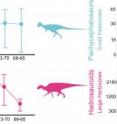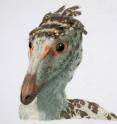Were dinosaurs undergoing long-term decline before mass extinction?
Despite years of intensive research about the extinction of non-avian dinosaurs about 65.5 million years ago, a fundamental question remains: were dinosaurs already undergoing a long-term decline before an asteroid hit at the end of the Cretaceous? A study led by scientists at the American Museum of Natural History gives a multifaceted answer. The findings, published online May 1 in Nature Communications, suggest that in general, large-bodied, "bulk-feeding" herbivores were declining during the last 12 million years of the Cretaceous. But carnivorous dinosaurs and mid-sized herbivores were not. In some cases, geographic location might have been a factor in the animals' biological success.
"Few issues in the history of paleontology have fueled as much research and popular fascination as the extinction of non-avian dinosaurs," said lead author Steve Brusatte, a Columbia University graduate student affiliated with the Museum's Division of Paleontology. "Did sudden volcanic eruptions or an asteroid impact strike down dinosaurs during their prime? We found that it was probably much more complex than that, and maybe not the sudden catastrophe that is often portrayed."
The research team, which includes Brusatte; Mark Norell, chair of the Museum's Division of Paleontology; and scientists Richard Butler of Ludwig Maximilian University of Munich and Albert Prieto-M‡rquez from the Bavarian State Collection for Palaeontology, both in Germany, is the first to look at dinosaur extinction based on "morphological disparity"-the variability of body structure within particular groups of dinosaurs. Previous research was based almost exclusively on estimates of changes in the number of dinosaur species over time. However, it can be very difficult to do this accurately.
"By looking just at trends in taxonomic diversity, you get conflicting answers about the state of dinosaurs prior to extinction," Brusatte said. "This is because the results can be biased by uneven sampling of the fossil record. In places where more rock and fossils were formed, like in America's Great Plains, you'll find more species. We wanted to go beyond a simple species count for this study."
By looking at the change in biodiversity within a given dinosaur group over time, researchers can create a rough snapshot of the animals' overall well-being. This is because groups that show an increase in variability might have been evolving into more species, giving them an ecological edge. On the other hand, decreasing variability might be a warning sign of extinction in the long term.
The researchers calculated morphological disparity for seven major dinosaur groups using databases that include wide-ranging characteristics about the intricate skeletal structure of nearly 150 different species.
"People often think of dinosaurs as being monolithic-we say 'The dinosaurs did this, and the dinosaurs did that,'" Butler said. "But dinosaurs were hugely diverse. There were hundreds of species living in the Late Cretaceous, and these differed enormously in diet, shape, and size. Different groups were probably evolving in different ways and the results of our study show that very clearly."
The researchers found that hadrosaurs and ceratopsids, two groups of large-bodied, bulk-feeding herbivores-animals that did not feed selectively-may have experienced a decline in biodiversity in the 12 million years before the dinosaurs ultimately went extinct. In contrast, small herbivores (ankylosaurs and pachycephalosaurs), carnivorous dinosaurs (tyrannosaurs and coelurosaurs), and enormous herbivores without advanced chewing abilities (sauropods) remained relatively stable or even slightly increased in biodiversity.
As a complication, hadrosaurs showed different levels of disparity in different locations. While declining in North America, the disparity of this dinosaur group seems to have been increasing in Asia during the latest Cretaceous.
"These disparity calculations paint a more nuanced picture of the final 12 million years of dinosaur history," Brusatte said. "Contrary to how things are often perceived, the Late Cretaceous wasn't a static 'lost world' that was violently interrupted by an asteroid impact. Some dinosaurs were undergoing dramatic changes during this time, and the large herbivores seem to have been mired in a long-term decline, at least in North America."
In North America, extreme fluctuations of the inland Western Interior Sea and mountain building might have affected the evolution of dinosaurs in distinct ways from species on other continents. Therefore, the authors say, the North American record might not be representative of a global pattern, if one exists. They also note that there is no way to tell whether a declining dinosaur group would have survived if the asteroid had not struck Earth.
"Even if the disparity of some dinosaur clades or regional faunas were in decline, this does not automatically mean that dinosaurs were doomed to extinction," Norell said. "Dinosaur diversity fluctuated throughout the Mesozoic, and small increases or decreases between two or three time intervals may not be noteworthy within the context of the entire 150-million-year history of the group."
Funding for this study was provided by the National Science Foundation through the Division of Earth Sciences, the Division of Biological Infrastructure, a Graduate Research Fellowship, and a Doctoral Dissertation Improvement Grant; the German Research Foundation's Emmy Noether Programme; the Alexander von Humboldt Foundation; the Charlotte and Walter Kohler Charitable Trust; the American Museum of Natural History; and Columbia University.
Source: American Museum of Natural History
Other sources
- Were dinosaurs undergoing long-term decline before mass extinction? |video| @GrrlScientistfrom The Guardian - ScienceThu, 3 May 2012, 8:30:40 UTC
- New theory on dinosaur extinction offeredfrom UPITue, 1 May 2012, 23:30:22 UTC
- New theory on dinosaur extinction offeredfrom UPITue, 1 May 2012, 23:00:21 UTC
- Were dinosaurs undergoing long-term decline before mass extinction?from Science DailyTue, 1 May 2012, 19:10:20 UTC
- Dinosaurs dying out before asteroid — maybefrom MSNBC: ScienceTue, 1 May 2012, 18:00:54 UTC
- Dinosaurs dying out before asteroid — maybefrom MSNBC: ScienceTue, 1 May 2012, 17:30:46 UTC
- Space rock caught some dinosaurs already in decline: studyfrom PhysorgTue, 1 May 2012, 16:01:11 UTC


